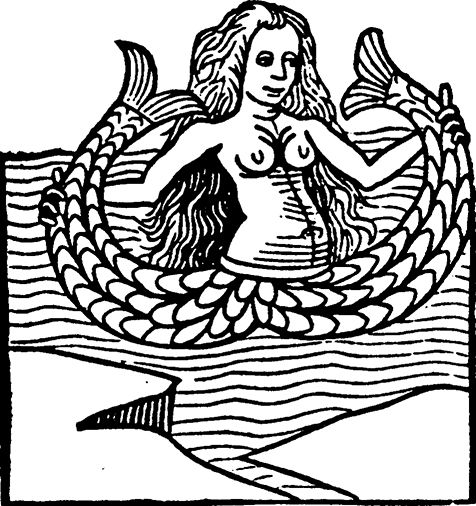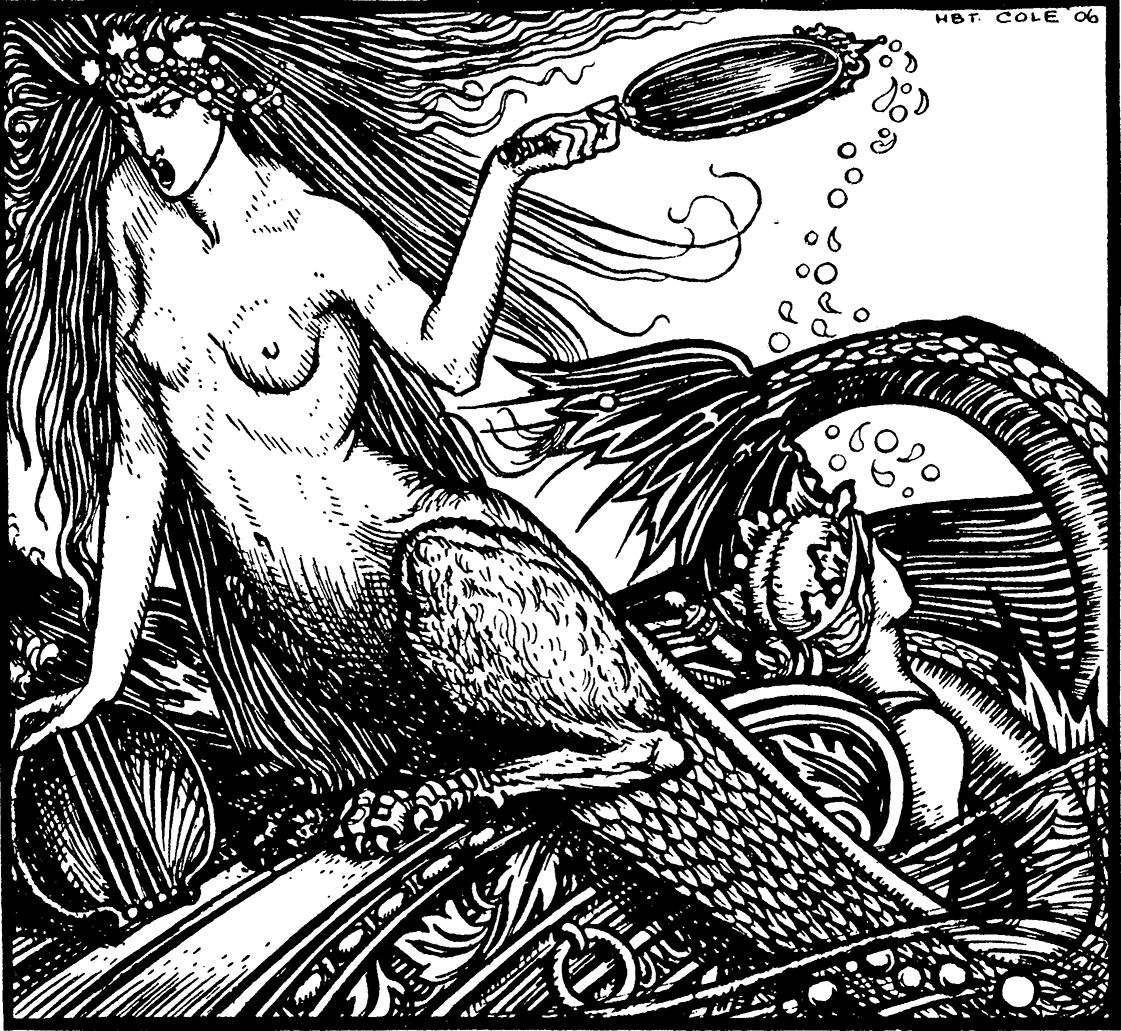 —Manly P. Hall, The Secret Teachings of All Ages
—Manly P. Hall, The Secret Teachings of All Ages 
MERMAIDS HAVE FASCINATED and mystified us for millennia—so there must be something more to them than their pretty faces and figures. Symbols only endure if they touch upon a truth that resonates deep within us, a truth that is both personal and universal. Mythology and art frequently use symbols to convey meanings—especially in earlier times when most people couldn’t read or write—and the mermaid is a provocative symbol, today as well as in the past.
What do mermaids have to say to us? You’ve learned a lot throughout this book, but let’s take a second look at some of the symbolism attached to mermaids and the hidden messages these lovely ladies are trying to send us. As we do, let’s also reflect back on the significance of mermaids through the ages and what we can learn from them today.
A Return to the Sea
“[Water] has always been a feminine symbol—it is natural that the water spirits should most often be symbolized as female.”
 —Manly P. Hall, The Secret Teachings of All Ages
—Manly P. Hall, The Secret Teachings of All Ages 
Science tells us that all life on Earth evolved from the ocean, the “womb of the world.” Not only is the sea home to the mermaid, it is our primordial home as well. When we see a mermaid riding happily on the waves, we’re reminded of our origins. When she beckons us to follow her into her underwater realm, we feel, perhaps, a twinge of longing to return to the soothing, weightlessness of the womb where we once floated comfortably in a salty sea of amniotic fluid.
Our bodies—and especially our brains—contain a high percentage of water. So even though we can’t breathe underwater, like mermaids do, we sense an affinity with water—it’s as if we haven’t entirely left our past behind. As a hybrid being, the mermaid symbolizes our transformation from fish to Homo sapiens. We identify with her because, like the mermaid, we’re still partly creatures of the sea.
Early people linked not only mermaids but also goddesses with the waters of the world. The oceans, rivers, and lakes provided nourishment—without them, human beings couldn’t survive. These potent goddesses held the power of life and death in their hands. Our ancestors honored the water deities, seeking to win their favor and their life-giving blessings. Over time, their majesty was transferred to mermaids. Like the sea itself, mermaids could bring good fortune or devastation. That mysterious power still entices us today.
Sensual Sirens
No one can deny the sexual allure of the mermaid. Even Disney’s cute cartoon character Ariel retains a not-so-subtle symbol of passion—her fiery red hair. Historically, hair has been associated with power, and a woman’s hair represented sexual power specifically. Supposedly, men found women’s hair so deliciously distracting that for centuries religions forbade females to display their tempting tresses publicly—and certainly not in church! In the prim and proper Victorian era, women bound up their hair, symbolically reining in their power and taming it, lest they drive men wild.
Beautiful, bare-breasted mermaids have tempted seamen for centuries. Virtually all legends describe mermaids as exquisitely good-looking, with perfectly shaped full breasts, silky-smooth skin, and the slim torsos of lovely young women. Their unabashed willingness to display their luscious bodies added to their appeal—especially when human females were extolled to keep theirs covered up. During the days when sailing ships still navigated the seas, painters weren’t allowed to portray real women in the nude—but goddesses and mermaids could flaunt their naked glory with abandon.
If mermaids evolved from the early fertility goddesses, as many researchers believe, it’s only natural for them to continue on as sex symbols. The Assyrian goddess Atargartis, who became our first mermaid, was an important fertility deity. So were the African goddesses Yemaja and Oshun, the Greeks’ Aphrodite, and the Romans’ Venus. To our ancestors, the female’s ability to bring forth life gave her a magical power that made her absolutely awesome.
The Mermaid’s Tail
What’s sexy about a fishtail? In The Republic of Love, Carol Shields describes it as “a sealed vessel enclosing either sexual temptation or sexual virtue, or some paradoxical and potent mixture of the two.” In fact, part of the mermaid’s appeal may be her sexual unattainability—we always want what we can’t have. She’s the ultimate tease. Here’s this gorgeous babe with the breasts of a Playboy bunny, the face of an angel, and the long, flowing hair of a supermodel—but a man can never consummate a relationship with her because her tail prevents access to her “lady parts.”
The mermaid’s tail is one of her most obvious and intriguing symbols. But her tail didn’t always look the way it does now. She wasn’t always so restrained. As we discussed in Chapter 2, early depictions of mermaids often showed them with two tails or a tail split down the middle, suggesting that they could take on human lovers after all. Remember the first mermaid Starbucks used for its logo? That half-naked beauty was of the two-tailed variety and she provocatively parted her tails, holding them up on either side of her bare torso, enticing customers with her charms.

The twin-tailed mermaid reminds us of the ancient Sheila-na-gig fertility goddesses of the pre-Christian Celts. This brazen and bawdy baubo deity squats to reveal her genitals as a symbol of feminine power. So it would seem that the early mermaid retained a close connection with the old fertility goddesses—and the creative power they possessed—which later versions attempted to diminish by cocooning her lower body in a single tail.
Beauty and Vanity
“Her mirror, later a symbol of her vanity, originally represented the planet Venus in astrological tradition. Her abundant, flowing hair, symbolizing an abundant love potential, was also an attribute of Venus in her role as fertility goddess.”
 —Scarlett deMason, “Shadows of the Goddess—The Mermaid”
—Scarlett deMason, “Shadows of the Goddess—The Mermaid” 
Always looking in the mirror and combing her hair, the mermaid certainly strikes us as one vain female. Then there’s her penchant for decking herself out in jewels—which some legends say she scavenged from the treasure chests of sunken ships. Of course, she’s drop-dead gorgeous to begin with, as many a sailor will attest. But if her looks alone aren’t enough to garner attention from passing seafarers, the mermaid sings out in the most enchanting voice until no man can resist her.
Vanity, as you recall, is one of the seven deadly sins, and early churches used the symbolism of the mermaid to remind the faithful of this fact. Comb-and-mirror-toting mermaids adorned many a sanctuary wall in medieval churches—frequently swimming among schools of fish, which symbolized Christianity. In a sixteenth-century Cornish church, a wooden pew features a carving of a mermaid holding her mirror and comb—a warning, perhaps, for legends say mermaids dragged many Cornwall men down to their deaths in the sea.
But you can’t really blame mermaids for being such narcissists. Mythology says these fascinating females descended from the ancient goddesses of love and beauty: Aphrodite and Venus. These delectable deities governed art, music, poetry, love, and the finer things in life. It was their job not only to look good, but to enrich the world with beauty in all its many forms. And as we know too well, there’s enough ugliness in the world—maybe we need mermaids to add a touch of glamour and grace.

THE MERMAID’S MAGIC MIRROR
Often considered a sign of vanity, the mermaid’s mirror is a symbol of something else as well. Like magic mirrors everywhere, it gives her clairvoyant skills and lets her view the future. Thus, her mirror represents the ability to see through the “veil” that mystics say separates the visible and spirit worlds.
Creators and Destroyers
Historically, mermaids represented danger. It wasn’t until the Victorian era that they started appearing as fantasy friends in children’s books and as nubile Lolitas on the walls of gentlemen’s chambers.
Most legends and folklore portray mermaids as temptresses who lure human beings—mostly men—into the water and drown them. Other tales warn seafarers of the mermaid’s capricious nature—she simply can’t be trusted. She might protect sailors on their ocean voyages or brew up ferocious storms to sink their ships. You just never know.
The mermaid’s song, mythology tells us, is one of her most seductive and deadly attributes. Ever since the Greek Sirens tormented Odysseus, mermaids have been singing men to sleep—permanently. Mermaids’ enchanting voices mess with seamen’s minds so intensely that they run their ships aground or jump, delirious, into the sea and perish.
But mermaids aren’t all bad. Many of them, such as Japan’s Benton, bring good luck and happiness to people. The Africans’ Mami Wata provides food, shelter, and prosperity to human beings. Other mermaids, such as Oshun, heal the sick. The Warsaw mermaid serves as the city’s protectress and benefactor. Folklore says that mermaids can grant wishes, too.
Mermaids follow in the footsteps of the ancient goddesses, who provided water for crops and food for people. But they also caused devastating storms and floods. The goddesses gave and the goddesses took away. The mermaid’s dual nature actually adds to her allure. The combination of desirability and danger makes her infinitely intriguing—and for men who enjoy a challenge, she’s irresistible.
Wise Women
Today’s mermaids may epitomize the “dumb blonde” image or appear as cute, cuddly playmates. But myths and folklore often present them as wise women with the power to heal, teach, and guide human beings. Ancient Sumerian myths say mermaids educated people and taught them science and the arts. The Babylonian merman Ea shared his knowledge of agriculture and architecture with humans. The Caribbean mermaid Lasirèn takes people underwater and gives them special powers, including psychic ability.
In myth and psychology, water symbolizes the emotions, intuition, and the unconscious. Because the mermaid lives in the water, she has access to these areas, whereas humans often ignore them. The mermaid plumbs the ocean’s depths—and the unconscious—bringing up treasure she finds at the bottom. Spiritual teachers and therapists advise that in order to be happy, healthy, and wise, we must get in touch with our emotions and our inner selves. The mermaid’s ability to breathe underwater and to gracefully ride the ocean’s waves indicates that she understands this very well.